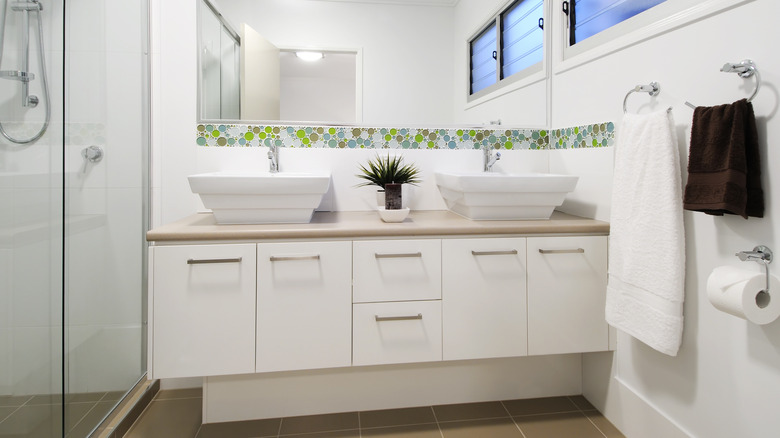The Biggest Difference Between An Expensive And An Affordable Bathroom Vanity Explained
Like the bed in your bedroom, a bathroom vanity is a focal point of the room that instantly draws the eye and sets the tone for the rest of the space's design. For a bathroom to convey luxury, the vanity will have to do much of the work, but if you're working on a budget, you might not have the flexibility to opt for a more elaborate fixture. Before you start your bathroom remodel and go with the budget-friendly pick to save a few dollars, you should note that the main differences between the options, such as construction and materials, hold significant weight.
Budget-friendly bathroom vanities are usually made with cheaper materials such as medium-density fiberboard (MDF), plywood, and particle board. On the other hand, luxury vanities are made from an array of materials, like stone and solid wood, that are higher in cost since they hold up better to daily wear and tear and do more to elevate the room's design. Additionally, though cheaper vanities may keep your bank account looking good, they tend to need replacing quicker and can often be difficult (if not impossible) to adequately repair.
Bathroom vanity materials explained
Bathrooms tend to be humid and wet, so your vanity needs to be constructed with materials capable of handling consistent moisture to last a long time. MDF is a common material found in cheaper vanities. Still, its combination of wax and synthetic resin is one of the weakest for the bathroom in terms of durability since it's prone to swell due to humidity. Particle board, made of wood particles and glue, is another material found in cheaper vanities that, similar to MDF, becomes damaged quickly from prolonged steam exposure. Plywood is slightly more durable and resists warping better than the aforementioned options. As such, it's a fairly solid choice in terms of both durability and affordability.
On the other end of the spectrum, solid wood is a safe choice for a high-end vanity, but it still requires careful consideration. Wood expands when exposed to water if not finished with a moisture-resistant coating, such as polyurethane. Solid hardwood (built from specific types of wood, such as maple, cherry, and oak) is also porous but is likely to last longer than other solid woods in a humid bathroom environment.
Choosing between affordable and luxury
When choosing the perfect bathroom vanity, it can feel tempting to select a more affordable option to stay in line with your budget. However, this might pose problems in the long run. With certain inexpensive vanity materials like MDF and particle board being susceptible to moisture, you might find that they're not a budget-friendly deal after they need to be replaced prematurely; this is especially important if you have a high-traffic bathroom with poor ventilation. The average low-end vanity costs between $149-$1,600, while the average cost of a solid wood vanity ranges from $500-$2,500+. Though there are a lot of other factors that contribute to the price of your vanity (size, double sinks, style, etc.), investing in a luxury model that's well-constructed and moisture-resistant can save you the trouble of finding a swift replacement.
Taking careful stock of a piece's stability is also a good idea. You'll notice cheaper vanities tend to be more wobbly, whereas luxury ones contain a heaviness that keeps them in place. Since you plan on having yours for the long haul, opt for a stable model that isn't likely to bend and buckle under frequent use. While this will cost more, solid wood vanities are much easier to fix and restore than MDF and particleboard counterparts should the need ever arise.


